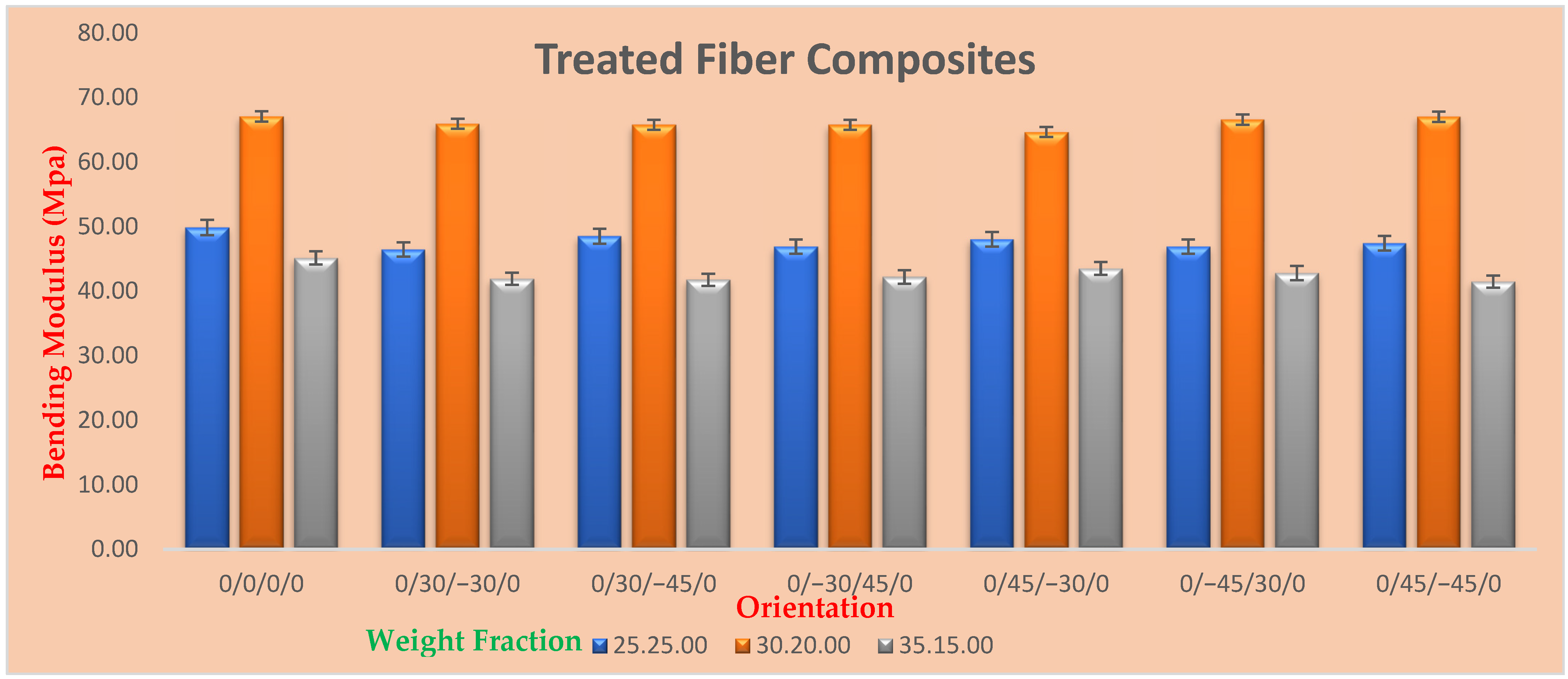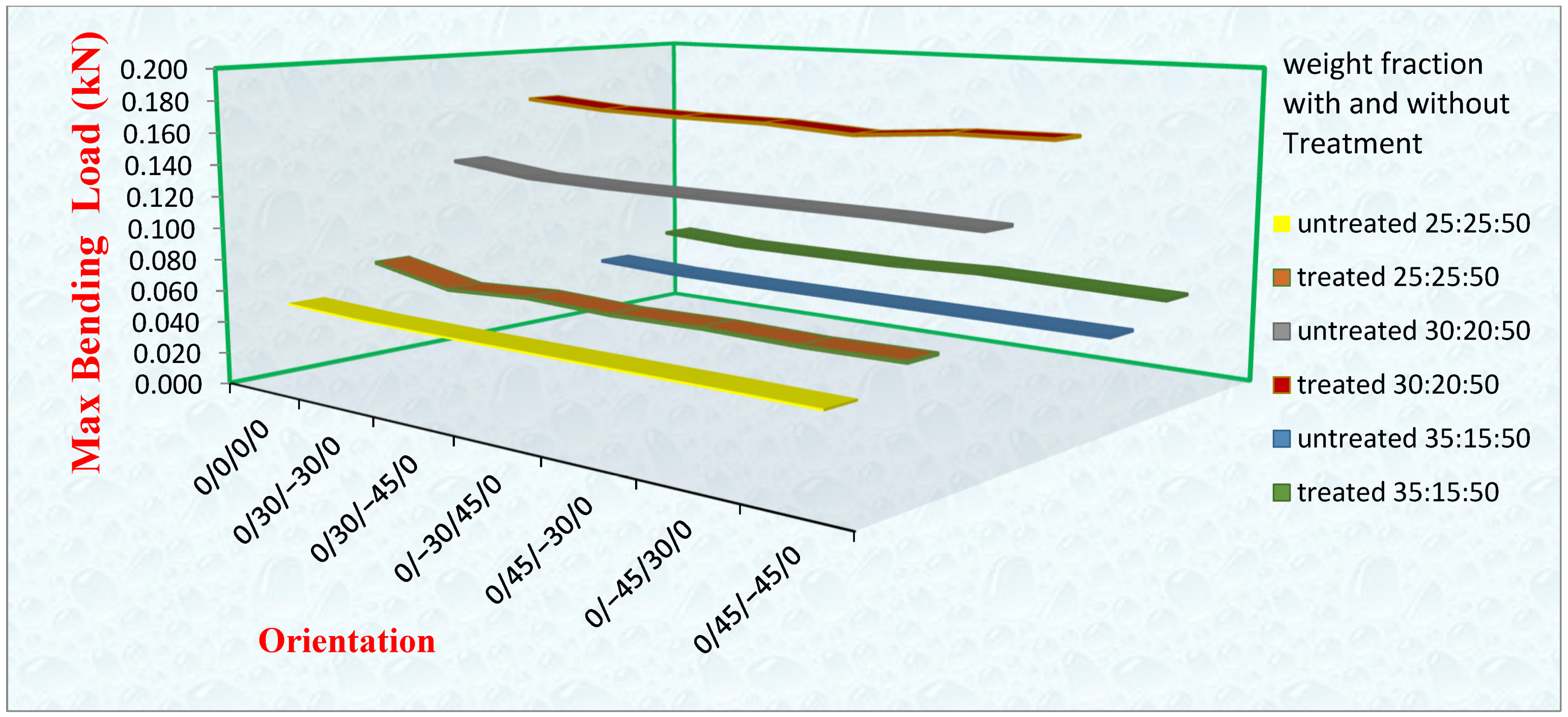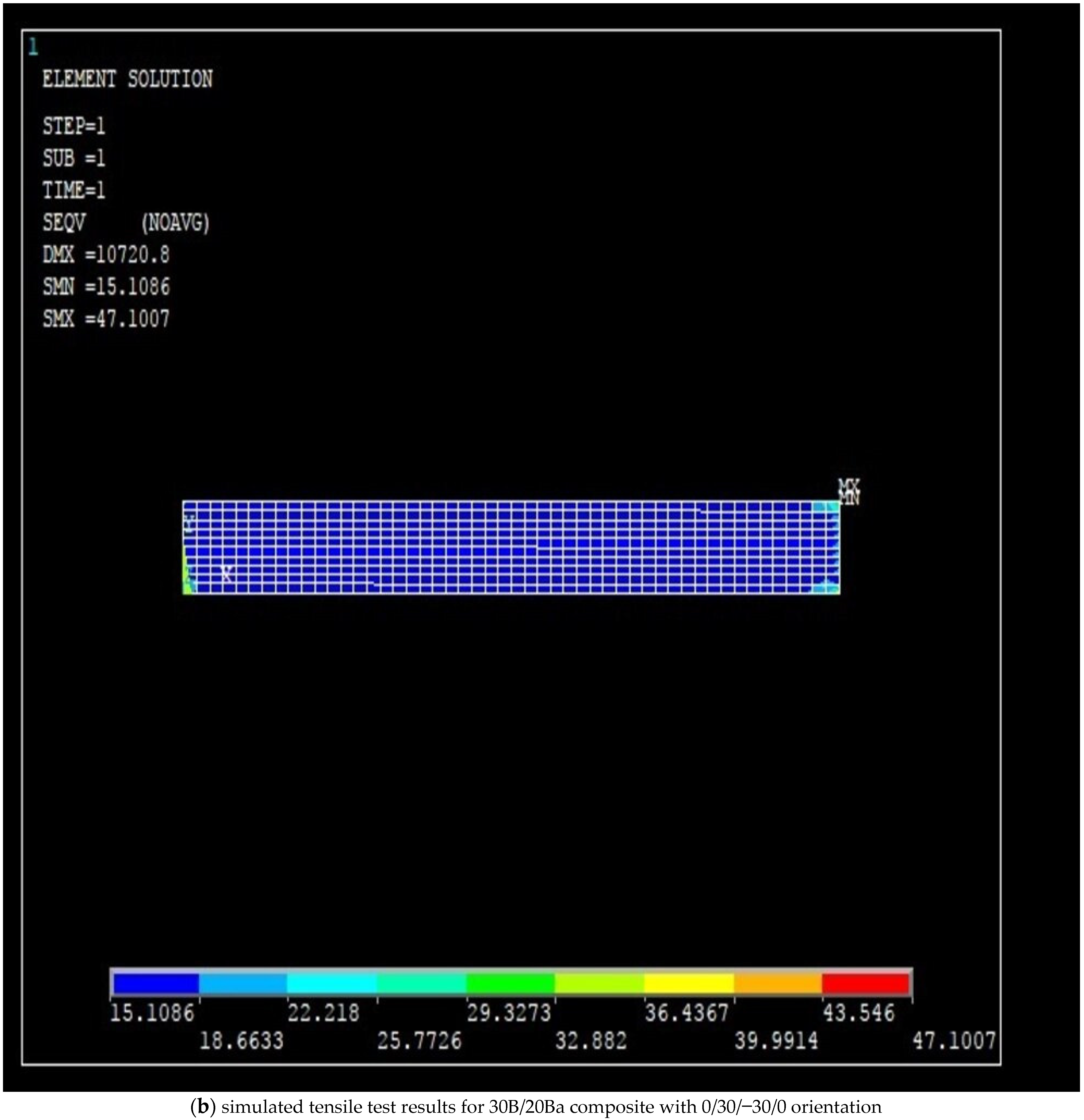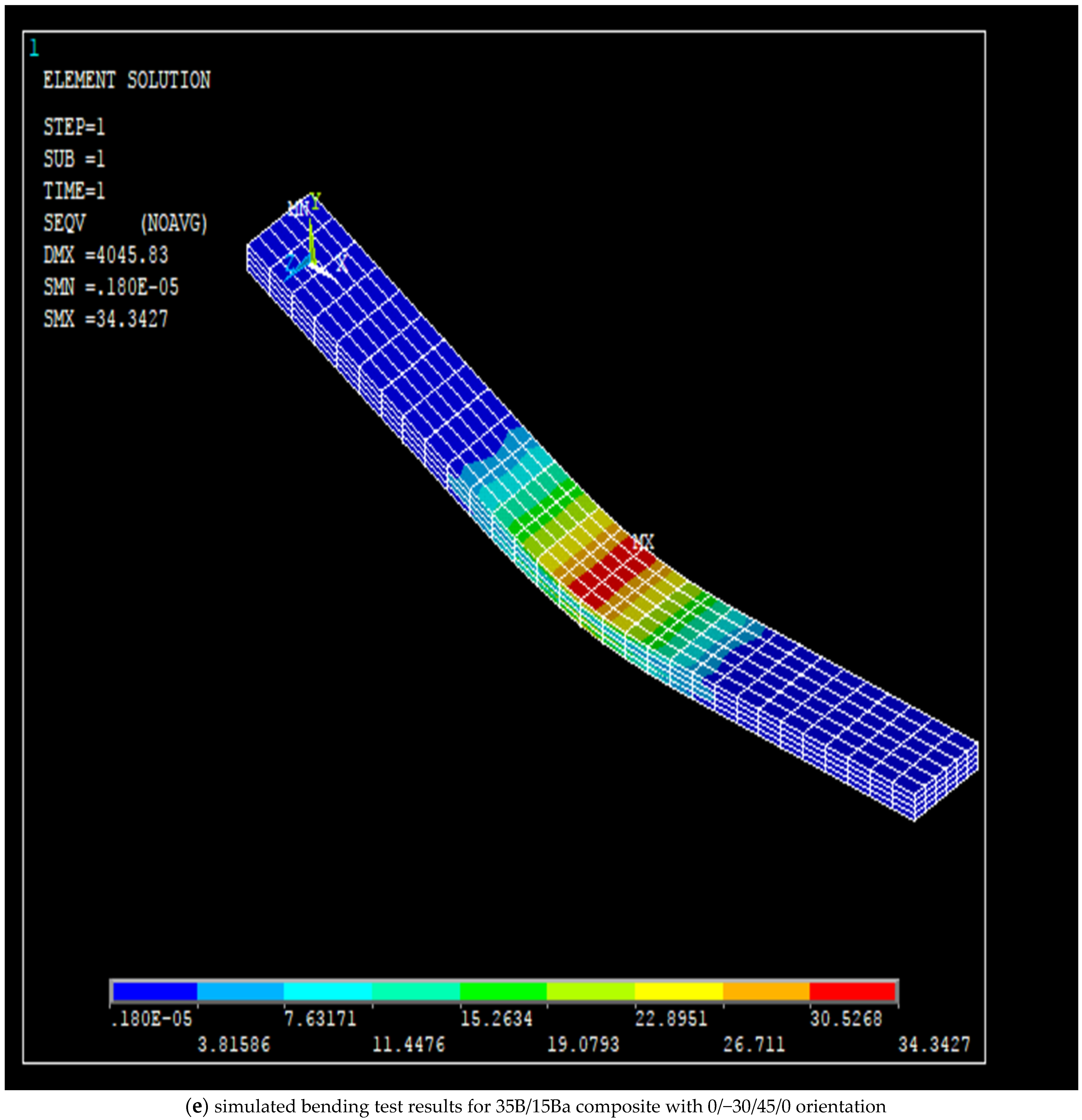The Behavior of Banyan (B)/Banana (Ba) Fibers Reinforced Hybrid Composites Influenced by Chemical Treatment on Tensile, Bending and Water Absorption Behavior: An Experimental and FEA Investigation
Abstract
1. Introduction
2. Materials and Methods
2.1. Materials
2.2. Preparation of Reinforcement and Matrix Material
2.3. Composite Sample Preparations
2.4. Characterization Methods
2.4.1. Tensile Test
2.4.2. Flexural Test
2.4.3. Water Absorption Test
2.4.4. Finite Element Analysis
3. Results and Discussions
3.1. Effect of Fibers on Tensile Properties
3.2. Effect of Fibers on Flexural Properties
3.3. The Effect of Water Absorption
3.4. Simulation Results
4. Conclusions
- (i)
- The major study is focused on the comparison of treated and untreated natural fiber composite properties, and the results clearly show that the chemically treated fiber composites were enhanced in tensile and bending strengths with a range of 26.9% to 31.2%.
- (ii)
- Chemical treatment of fibers will improve the tensile and flexural strength in banyan (B) and banana (Ba) hybrid composites and can give higher values of 63.37 MPa and 67.07 MPa, respectively, in 0/0/0/0-orientation composites.
- (iii)
- A volume fraction of 30% banyan fibers and 20% banana fibers (30B/20Ba) yielded higher tensile and flexural properties for both treated and untreated fibers with 0/0/0/0-orientation composites compared to other volume fraction and orientation composites.
- (iv)
- Both FEA and experimental results showed a similar trend in maximum stress (strength) in composites, but FEA results are proven to be fair up to 7.36% higher than the experimental results, and the stress concentration region was due to applied load according to simulation parameters.
- (v)
- With the increase in duration of immersion of composites in water, there will be an increase in water absorption for up to 144 h in both treated and untreated composites. However, the treated fiber composites have less water absorption compared to untreated fiber composites.
Author Contributions
Funding
Data Availability Statement
Conflicts of Interest
References
- Shyam, S.; Kaul, S.; Kalsara, N.; Babu, T.N. Mechanical behaviour and microscopic analysis of epoxy and E-glass reinforced banyan fibre composites with the application of artificial neural network and deep neural network for the automatic prediction of orientation. J. Compos. Mater. 2021, 55, 213–234. [Google Scholar] [CrossRef]
- Bichang’a, D.; Aramide, F.; Oladele, I.; Alabi, O. A Review on the Parameters Affecting the Mechanical, Physical, and Thermal Properties of Natural/Synthetic Fibre Hybrid Reinforced Polymer Composites. Adv. Mater. Sci. Eng. 2022, 2022, 7024099. [Google Scholar] [CrossRef]
- Aravindh, M.; Sathish, S.; Raj, R.R.; Karthick, A.; Mohanavel, V.; Patil, P.P.; Muhibbullah, M.; Osman, S.M. A Review on the Effect of Various Chemical Treatments on the Mechanical Properties of Renewable Fiber-Reinforced Composites. Adv. Mater. Sci. Eng. 2022, 2022, 2009691. [Google Scholar] [CrossRef]
- Raja, T.; Mohanavel, V.; Sathish, T.; Djearamane, S.; Velmurugan, P.; Karthick, A.; Nasif, O.; Alfarraj, S.; Wong, L.S.; Sureshkumar, S.; et al. Thermal and Flame Retardant Behavior of Neem and Banyan Fibers When Reinforced with a Bran Particulate Epoxy Hybrid Composite. Polymers 2021, 13, 3859. [Google Scholar] [CrossRef]
- Al Rashid, A.; Khalid, M.Y.; Imran, R.; Ali, U.; Koc, M. Utilization of Banana Fiber-Reinforced Hybrid Composites in the Sports Industry. Materials 2020, 13, 3167. [Google Scholar] [CrossRef]
- Rana, P.; Chopra, S. Extraction and Characterization of Inherently Antimicrobial Fibres from Aerial Roots of Banyan Tree. J. Nat. Fibers 2022, 19, 6196–6213. [Google Scholar] [CrossRef]
- Begum, H.A.; Tanni, T.R.; Shahid, A. Analysis of Water Absorption of Different Natural Fibers. J. Text. Sci. Technol. 2021, 7, 152–160. [Google Scholar] [CrossRef]
- Raja, T.; Anand, P.; Karthik, K.; Udaya Prakash, J. Mechanical properties and moisture behaviour of neem/banyan fibres reinforced with polymer matrix hybrid composite. Adv. Mater. Process. Technol. 2021, 7, 1–12. [Google Scholar]
- Thiagamani, S.M.K.; Krishnasamy, S.; Muthukumar, C.; Tengsuthiwat, J.; Nagarajan, R.; Siengchin, S.; Ismail, S.O. Investigation into mechanical, absorption and swelling behaviour of hemp/sisal fibre reinforced bioepoxy hybrid composites: Effects of stacking sequences. Int. J. Biol. Macromol. 2019, 140, 637–646. [Google Scholar] [CrossRef]
- Ganapathy, T.; Sathiskumar, R.; Senthamaraikannan, P.; Saravanakumar, S.; Khan, A. Characterization of raw and alkali treated new natural cellulosic fibres extracted from the aerial roots of banyan tree. Int. J. Biol. Macromol. 2019, 138, 573–581. [Google Scholar] [CrossRef]
- Prabowo, I.; Pratama, J.N.; Chalid, M. The effect of modified ijuk fibers to crystallinity of polypropylene composite. IOP Conf. Series Mater. Sci. Eng. 2016, 223, 012020. [Google Scholar] [CrossRef]
- Supian, A.; Jawaid, M.; Rashid, B.; Fouad, H.; Saba, N.; Dhakal, H.N.; Khiari, R. Mechanical and physical performance of date palm/bamboo fibre reinforced epoxy hybrid composites. J. Mater. Res. Technol. 2021, 15, 1330–1341. [Google Scholar] [CrossRef]
- Sujon, A.S.; Habib, M.A.; Abedin, M.Z. Experimental investigation of the mechanical and water absorption properties on fiber stacking sequence and orientation of jute/carbon epoxy hybrid composites. J. Mater. Res. Technol. 2020, 9, 10970–10981. [Google Scholar] [CrossRef]
- Arshad, M.N.; Mohit, H.; Sanjay, M.R.; Siengchin, S.; Khan, A.; Alotaibi, M.M.; Asiri, A.M.; Rub, M.A. Effect of coir fiber and TiC nanoparticles on basalt fiber reinforced epoxy hybrid composites: Physico–mechanical characteristics. Cellulose 2021, 28, 3451–3471. [Google Scholar] [CrossRef]
- Jawaid, M.; Thariq, M.; Saba, N. (Eds.) Failure Analysis in Biocomposites, Fibre-Reinforced Composites and Hybrid Composite, 1st ed.; Woodhead Publishing: Duxford, UK, 2019; pp. 133–153. [Google Scholar]
- Kumar, V.J.B.; Raj, J.B.; Karuppasamy, R.; Thanigaivelan, R. Influence of Chemical Treatment and Moisture Absorption on Tensile Behavior of Neem/banana Fibers Reinforced Hybrid Composites: An Experimental Investigation. J. Nat. Fibers 2022, 19, 3051–3062. [Google Scholar] [CrossRef]
- Ganapathy, T.; Sathiskumar, R.; Sanjay, M.R.; Senthamaraikannan, P.; Saravanakumar, S.S.; Parameswaranpillai, J.; Siengchin, S. Effect of Graphene Powder on Banyan Aerial Root Fibers Reinforced Epoxy Composites. J. Nat. Fibers 2021, 18, 1029–1036. [Google Scholar] [CrossRef]
- Raj, M.K.A.; Muthusamy, S.; Panchal, H.; Ibrahim, A.M.M.; Alsoufi, M.S.; Elsheikh, A.H. Investigation of mechanical properties of dual-fiber reinforcement in polymer composite. J. Mater. Res. Technol. 2022, 18, 3908–3915. [Google Scholar]
- Dhanunjayarao, B.; Sanivada, U.K.; Naidu, N.S.; Fangueiro, R. Effect of graphite particulate on mechanical characterization of hybrid polymer composites. J. Ind. Text. 2022, 51, 2594S–2615S. [Google Scholar] [CrossRef]
- Vinod, A.; Vijay, R.; Singaravelu, D.L.; Khan, A.; Sanjay; Siengchin, S.; Verpoort, F.; Alamry, K.A.; Asiri, A.M. Effect of alkali treatment on performance characterization of Ziziphus mauritiana fiber and its epoxy composites. J. Ind. Text. 2022, 51, 2444S–2466S. [Google Scholar] [CrossRef]
- Raja, T.; Vinayagam, M.; Thanakodi, S.; Seikh, A.H.; Siddique, M.H.; Subbiah, R.; Gebrekidan, A.M. Mechanical Properties of Banyan Fiber-Reinforced Sawdust Nanofiller Particulate Hybrid Polymer Composite. J. Nanomater. 2022, 2022, 9475468. [Google Scholar] [CrossRef]
- Ganesamoorthy, R.; Reddy, R.M.; Raja, T.; Panda, P.K.; Dhoria, S.H.; Nasif, O.; Alfarraj, S.; Manikandan, V.; Jenish, I. Studies on Mechanical Properties of Kevlar/Napier Grass Fibers Reinforced with Polymer Matrix Hybrid Composite. Adv. Mater. Sci. Eng. 2021, 2021, 6907631. [Google Scholar] [CrossRef]
- Izwan, S.M.; Sapuan, S.; Zuhri, M.; Mohamed, A. Effects of Benzoyl Treatment on NaOH Treated Sugar Palm Fiber: Tensile, Thermal, and Morphological Properties. J. Mater. Res. Technol. 2020, 9, 5805–5814. [Google Scholar] [CrossRef]
- Devnani, G.; Mittal, V.; Sinha, S. Mathematical modelling of water absorption behavior of bagasse fiber reinforced epoxy composite material. Mater. Today Proc. 2018, 5, 16912–16918. [Google Scholar] [CrossRef]
- Sanjeevi, S.; Shanmugam, V.; Kumar, S.; Ganesan, V.; Sas, G.; Johnson, D.J.; Shanmugam, M.; Ayyanar, A.; Naresh, K.; Neisiany, R.E.; et al. Effects of water absorption on the mechanical properties of hybrid natural fiber/phenol formaldehyde composites. Sci. Rep. 2021, 11, 13385. [Google Scholar] [CrossRef]
- Kryszak, B.; Biernat, M.; Tymowicz-Grzyb, P.; Junka, A.; Brożyna, M.; Worek, M.; Dzienny, P.; Antończak, A.; Szustakiewicz, K. The effect of extrusion and injection molding on physical, chemical, and biological properties of PLLA/HAp whiskers composites. Polymer 2023, 287, 126428. [Google Scholar] [CrossRef]
















| % of Banyan (B)/ % Banana (Ba) | Total Matrix (%) | Banyan (B) (%) | Banana (Ba) (%) | Total Reinforcement (%) |
|---|---|---|---|---|
| 25B/25Ba | 50 | 25 | 25 | 50 |
| 30B/20Ba | 50 | 30 | 20 | 50 |
| 35B/15Ba | 50 | 35 | 15 | 50 |
| Materials | Young’s Modulus (GPa) | Poisson’s Ratio | Density (g/cm3) |
|---|---|---|---|
| Banyan (B) fibers | 1.5 | 0.24 | 1.92 |
| Banana (Ba) fibers | 3.5 | 0.28 | 1.35 |
| Epoxy resin | 2.8 | 0.35 | 1.19 |
| Weight Fraction → | 25B/25Ba | 30B/20Ba | 35B/15Ba | ||||||
|---|---|---|---|---|---|---|---|---|---|
| Orientations ↓ | Tensile Strength (MPa) | Tensile Modulus (GPa) | Max Load (kN) | Tensile Strength (MPa) | Tensile Modulus (GPa) | Max Load (kN) | Tensile Strength (MPa) | Tensile Modulus (GPa) | Max Load (kN) |
| 0/0/0/0 | 18.32 ± 0.15 | 1.16 ± 0.02 | 1.59 ± 0.01 | 49.16 ± 1.66 | 4.19 ± 0.13 | 5.86 ± 0.28 | 43.86 ± 1.20 | 3.88 ± 0.07 | 4.18 ± 0.07 |
| 0/30/−30/0 | 17.32 ± 0.14 | 1.09 ± 0.02 | 1.51 ± 0.01 | 44.76 ± 2.08 | 3.81 ± 0.12 | 5.33 ± 0.25 | 40.32 ± 1.11 | 3.56 ± 0.07 | 3.84 ± 0.06 |
| 0/30/−45/0 | 17.64 ± 0.20 | 1.11 ± 0.02 | 1.53 ± 0.01 | 46.02 ± 1.55 | 3.92 ± 0.12 | 5.48 ± 0.26 | 41.21 ± 1.13 | 3.64 ± 0.07 | 3.93 ± 0.06 |
| 0/−30/45/0 | 17.64 ± 0.14 | 1.11 ± 0.02 | 1.53 ± 0.01 | 46.02 ± 2.23 | 3.92 ± 0.12 | 5.48 ± 0.26 | 41.21 ± 1.13 | 3.64 ± 0.07 | 3.93 ± 0.06 |
| 0/45/−30/0 | 16.89 ± 0.13 | 1.07 ± 0.02 | 1.47 ± 0.01 | 43.71 ± 1.47 | 3.72 ± 0.12 | 5.21 ± 0.25 | 38.89 ± 1.50 | 3.44 ± 0.06 | 3.71 ± 0.06 |
| 0/−45/30/0 | 16.89 ± 0.18 | 1.07 ± 0.02 | 1.47 ± 0.01 | 43.71 ± 2.00 | 3.72 ± 0.12 | 5.21 ± 0.25 | 38.89 ± 1.10 | 3.44 ± 0.06 | 3.71 ± 0.06 |
| 0/45/−45/0 | 16.08 ± 0.25 | 1.01 ± 0.01 | 1.40 ± 0.01 | 43.98 ± 1.48 | 3.75 ± 0.12 | 5.24 ± 0.25 | 38.99 ± 1.80 | 3.45 ± 0.06 | 3.72 ± 0.06 |
| Weight Fraction → | 25B/25Ba | 30B/20Ba | 35B/15Ba | ||||||
|---|---|---|---|---|---|---|---|---|---|
| Orientations ↓ | Tensile Strength (MPa) | Tensile Modulus (GPa) | Max Load (kN) | Tensile Strength (MPa) | Tensile Modulus (GPa) | Max Load (kN) | Tensile Strength (MPa) | Tensile Modulus (GPa) | Max Load (kN) |
| 0/0/0/0 | 23.61 ± 0.51 | 1.49 ± 0.05 | 2.06 ± 0.03 | 63.37 ± 3.02 | 5.40 ± 0.8 | 7.55 ± 0.43 | 56.53 ± 2.22 | 5.00 ± 0.16 | 5.39 ± 0.07 |
| 0/30/−30/0 | 22.24 ± 0.48 | 1.40 ± 0.03 | 1.94 ± 0.04 | 58.73 ± 2.80 | 5.01 ± 0.26 | 7.00 ± 0.40 | 51.19 ± 2.01 | 4.53 ± 0.13 | 4.88 ± 0.06 |
| 0/30/−45/0 | 22.65 ± 0.49 | 1.43 ± 0.05 | 1.97 ± 0.03 | 60.38 ± 2.88 | 5.15 ± 0.21 | 7.20 ± 0.41 | 52.30 ± 2.06 | 4.62 ± 0.14 | 4.99 ± 0.10 |
| 0/−30/45/0 | 22.65 ± 0.49 | 1.43 ± 0.06 | 1.97 ± 0.02 | 60.38 ± 2.88 | 5.15 ± 0.19 | 7.20 ± 0.41 | 52.30 ± 2.06 | 4.62 ± 0.14 | 4.99 ± 0.06 |
| 0/45/−30/0 | 21.69 ± 0.48 | 1.43 ± 0.03 | 1.97 ± 0.08 | 57.35 ± 2.84 | 5.10 ± 0.19 | 7.13 ± 0.26 | 49.35 ± 2.09 | 4.61 ± 0.15 | 4.97 ± 0.08 |
| 0/−45/30/0 | 21.69 ± 0.9 | 1.43 ± 0.04 | 1.97 ± 0.03 | 57.35 ± 2.85 | 5.10 ± 0.26 | 7.13 ± 0.22 | 49.35 ± 2.05 | 4.61 ± 0.13 | 4.97 ± 0.10 |
| 0/45/−45/0 | 20.65 ± 0.45 | 1.30 ± 0.03 | 1.80 ± 0.02 | 57.70 ± 2.75 | 4.92 ± 0.25 | 6.88 ± 0.39 | 49.48 ± 1.95 | 4.37 ± 0.16 | 4.72 ± 0.06 |
| Weight Fraction → | 25B/25Ba | 30B/20Ba | 35B/15Ba | ||||||
|---|---|---|---|---|---|---|---|---|---|
| Orientations ↓ | Bending Strength (MPa) | Bending Modulus (GPa) | Max Load (kN) | Bending Strength (MPa) | Bending Modulus (GPa) | Max Load (kN) | Bending Strength (MPa) | Bending Modulus (GPa) | Max Load (kN) |
| 0/0/0/0 | 39.46 ± 1.34 | 0.05 ± 0.04 | 1.37 ± 0.001 | 54.58 ± 0.41 | 0.13 ± 0.05 | 3.95 ± 0.003 | 36.42 ± 0.14 | 0.04 ± 0.19 | 2.86 ± 0.002 |
| 0/30/−30/0 | 38.04 ± 1.29 | 0.05 ± 0.04 | 1.32 ± 0.001 | 52.08 ± 2.08 | 0.12 ± 0.13 | 3.77 ± 0.003 | 34.66 ± 0.13 | 0.04 ± 0.42 | 2.72 ± 0.002 |
| 0/30/−45/0 | 37.77 ± 0.20 | 0.05 ± 0.04 | 1.31 ± 0.001 | 51.61 ± 0.39 | 0.12 ± 0.18 | 3.73 ± 0.003 | 34.34 ± 0.13 | 0.04 ± 0.38 | 2.70 ± 0.002 |
| 0/−30/45/0 | 37.77 ± 1.28 | 0.05 ± 0.04 | 1.31 ± 0.001 | 51.61 ± 2.23 | 0.12 ± 0.13 | 3.73 ± 0.003 | 34.34 ± 0.13 | 0.04 ± 0.34 | 2.70 ± 0.002 |
| 0/45/−30/0 | 37.73 ± 014 | 0.05 ± 0.04 | 1.31 ± 0.001 | 51.59 ± 0.39 | 0.12 ± 0.15 | 3.73 ± 0.003 | 34.32 ± 1.50 | 0.04 ± 0.41 | 2.70 ± 0.002 |
| 0/−45/30/0 | 37.73 ± 0.18 | 0.05 ± 0.04 | 1.31 ± 0.001 | 51.59 ± 2.00 | 0.12 ± 0.13 | 3.73 ± 0.003 | 34.32 ± 1.10 | 0.04 ± 0.43 | 0.70 ± 0.002 |
| 0/45/−45/0 | 37.49 ± 0.25 | 0.05 ± 0.04 | 1.30 ± 0.001 | 51.21 ± 0.39 | 0.12 ± 0.18 | 3.71 ± 0.003 | 34.26 ± 1.80 | 0.04 ± 0.57 | 2.69 ± 0.002 |
| Weight Fraction → | 25B/25Ba | 30B/20Ba | 35B/15Ba | ||||||
|---|---|---|---|---|---|---|---|---|---|
| Orientations ↓ | Bending Strength (MPa) | Bending Modulus (GPa) | Max Load (kN) | Bending Strength (MPa) | Bending Modulus (GPa) | Max Load (kN) | Bending Strength (MPa) | Bending Modulus (GPa) | Max Load (kN) |
| 0/0/0/0 | 49.83 ± 1.19 | 0.07 ±0.04 | 1.77 ± 0.002 | 67.07 ± 0.81 | 0.16 ± 0.09 | 5.09 ± 0.002 | 45.11 ± 1.02 | 0.05 ± 0.06 | 3.69 ± 0.016 |
| 0/30/−30/0 | 46.45 ± 1.11 | 0.06 ± 0.05 | 1.56 ± 0.016 | 64.98 ± 0.79 | 0.16 ± 0.12 | 4.99 ± 0.022 | 41.74 ± 0.95 | 0.05 ± 0.21 | 3.40 ± 0.013 |
| 0/30/−45/0 | 46.90 ± 1.15 | 0.06 ± 0.10 | 1.63 ± 0.008 | 64.82 ± 0.79 | 0.16 ± 1.36 | 4.97 ± 0.021 | 41.59 ± 0.94 | 0.05 ± 0.20 | 3.38 ± 0.022 |
| 0/−30/45/0 | 46.90 ± 1.12 | 0.06 ± 0.08 | 1.57 ± 0.012 | 64.82 ± 0.78 | 0.16 ± 0.13 | 4.97 ± 0.058 | 41.53 ± 1.06 | 0.05 ± 0.10 | 3.38 ± 0.031 |
| 0/45/−30/0 | 46.11 ± 1.14 | 0.06 ± 0.08 | 1.61 ± 0.008 | 66.01 ± 0.77 | 0.16 ± 0.14 | 4.89 ± 0.003 | 40.95 ± 0.98 | 0.05 ± 0.16 | 3.53 ± 0.003 |
| 0/−45/30/0 | 46.34 ± 1.12 | 0.06 ± 0.18 | 1.57 ± 0.007 | 66.29 ± 0.80 | 0.16 ± 0.09 | 5.04 ± 0.011 | 40.91 ± 1.10 | 0.05 ± 0.12 | 3.43 ± 0.014 |
| 0/45/−45/0 | 45.85 ± 1.13 | 0.06 ± 0.09 | 1.59 ± 0.003 | 66.06 ± 0.81 | 0.16 ± 0.10 | 5.07 ± 0.024 | 41.31 ± 0.94 | 0.05 ± 0.22 | 3.3±0.018 |
| Mechanical Properties | Orientations | Untreated | FEA Untreated | Treated | FEA Treated | ||||||||
|---|---|---|---|---|---|---|---|---|---|---|---|---|---|
| 25B/ 25Ba | 30B/ 20Ba | 35B/ 15Ba | 25B/ 25Ba | 30B/ 20Ba | 35B/ 15Ba | 25B/ 25Ba | 30B/ 20Ba | 35B/ 15Ba | 25B/ 25Ba | 30B/ 20Ba | 35B/ 15Ba | ||
| Tensile strength (MPa) | 0/0/0/0 | 18.32 | 49.16 | 43.86 | 19.16 | 50.92 | 45.19 | 23.61 | 63.37 | 56.53 | 24.97 | 65.38 | 58.13 |
| 0/30/−30/0 | 17.32 | 44.76 | 40.32 | 18.13 | 47.10 | 42.17 | 22.24 | 58.73 | 51.19 | 23.17 | 62.69 | 54.40 | |
| 0/30/−45/0 | 17.64 | 46.02 | 41.21 | 18.42 | 48.03 | 43.10 | 22.65 | 60.38 | 52.30 | 23.54 | 63.93 | 55.60 | |
| 0/−30/45/0 | 17.64 | 46.02 | 41.21 | 18.42 | 48.03 | 43.100 | 22.65 | 60.38 | 52.30 | 23.54 | 63.93 | 55.60 | |
| 0/45/−30/0 | 16.89 | 43.71 | 38.89 | 17.46 | 45.84 | 41.15 | 21.69 | 57.35 | 49.35 | 22.31 | 61.01 | 53.08 | |
| 0/−45/30/0 | 16.89 | 43.71 | 38.89 | 17.46 | 45.84 | 41.15 | 21.69 | 57.35 | 49.35 | 22.31 | 61.01 | 53.08 | |
| 0/45/−45/0 | 16.08 | 43.98 | 38.99 | 17.26 | 45.11 | 40.40 | 20.65 | 57.70 | 49.48 | 22.06 | 60.04 | 52.12 | |
| Bending strength (MPa) | 0/0/0/0 | 39.46 | 54.58 | 36.42 | 39.46 | 54.58 | 36.42 | 49.83 | 67.07 | 45.11 | 50.85 | 68.89 | 46.75 |
| 0/30/−30/0 | 38.04 | 52.08 | 34.66 | 38.04 | 52.08 | 34.66 | 46.45 | 64.98 | 41.74 | 48.62 | 68.32 | 44.71 | |
| 0/30/−45/0 | 37.77 | 51.61 | 34.34 | 37.77 | 51.61 | 34.34 | 46.90 | 64.82 | 41.59 | 48.27 | 68.69 | 44.30 | |
| 0/−30/45/0 | 37.77 | 51.61 | 34.34 | 37.77 | 51.61 | 34.34 | 46.90 | 64.82 | 41.53 | 48.27 | 68.69 | 44.30 | |
| 0/45/−30/0 | 37.73 | 51.59 | 34.32 | 37.73 | 51.59 | 34.32 | 46.11 | 66.01 | 40.95 | 48.22 | 68.67 | 44.27 | |
| 0/−45/30/0 | 37.7 | 51.59 | 34.32 | 37.73 | 51.59 | 34.32 | 46.34 | 66.29 | 40.91 | 48.22 | 68.67 | 44.27 | |
| 0/45/−45/0 | 37.49 | 51.21 | 34.26 | 37.49 | 51.21 | 34.26 | 45.85 | 66.06 | 41.31 | 47.91 | 68.16 | 44.20 | |
Disclaimer/Publisher’s Note: The statements, opinions and data contained in all publications are solely those of the individual author(s) and contributor(s) and not of MDPI and/or the editor(s). MDPI and/or the editor(s) disclaim responsibility for any injury to people or property resulting from any ideas, methods, instructions or products referred to in the content. |
© 2024 by the authors. Licensee MDPI, Basel, Switzerland. This article is an open access article distributed under the terms and conditions of the Creative Commons Attribution (CC BY) license (https://creativecommons.org/licenses/by/4.0/).
Share and Cite
G, P.C.; Reddy, M.S.; Rajendrachari, S.; Mahale, R.S.; Mahesh, V.; Pandith, A. The Behavior of Banyan (B)/Banana (Ba) Fibers Reinforced Hybrid Composites Influenced by Chemical Treatment on Tensile, Bending and Water Absorption Behavior: An Experimental and FEA Investigation. J. Compos. Sci. 2024, 8, 31. https://doi.org/10.3390/jcs8010031
G PC, Reddy MS, Rajendrachari S, Mahale RS, Mahesh V, Pandith A. The Behavior of Banyan (B)/Banana (Ba) Fibers Reinforced Hybrid Composites Influenced by Chemical Treatment on Tensile, Bending and Water Absorption Behavior: An Experimental and FEA Investigation. Journal of Composites Science. 2024; 8(1):31. https://doi.org/10.3390/jcs8010031
Chicago/Turabian StyleG, Prabhakar C., M Sreenivas Reddy, Shashanka Rajendrachari, Rayappa Shrinivas Mahale, V. Mahesh, and Anup Pandith. 2024. "The Behavior of Banyan (B)/Banana (Ba) Fibers Reinforced Hybrid Composites Influenced by Chemical Treatment on Tensile, Bending and Water Absorption Behavior: An Experimental and FEA Investigation" Journal of Composites Science 8, no. 1: 31. https://doi.org/10.3390/jcs8010031
APA StyleG, P. C., Reddy, M. S., Rajendrachari, S., Mahale, R. S., Mahesh, V., & Pandith, A. (2024). The Behavior of Banyan (B)/Banana (Ba) Fibers Reinforced Hybrid Composites Influenced by Chemical Treatment on Tensile, Bending and Water Absorption Behavior: An Experimental and FEA Investigation. Journal of Composites Science, 8(1), 31. https://doi.org/10.3390/jcs8010031










